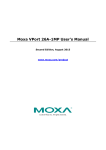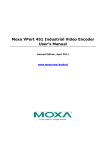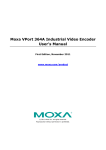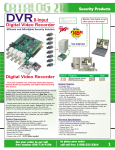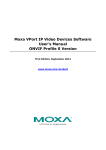Download Moxa VPort P06HC-1MP-M12 EN 50155 IP Camera User`s Manual
Transcript
Moxa VPort P06HC-1MP-M12 EN 50155 IP Camera User’s Manual First Edition, December 2013 www.moxa.com/product © 2013 Moxa Inc. All rights reserved. Moxa VPort P06HC-1MP-M12 EN 50155 IP Camera User’s Manual The software described in this manual is furnished under a license agreement and may be used only in accordance with the terms of that agreement. Copyright Notice © 2013 Moxa Inc. All rights reserved. Trademarks The MOXA logo is a registered trademark of Moxa Inc. All other trademarks or registered marks in this manual belong to their respective manufacturers. Disclaimer Information in this document is subject to change without notice and does not represent a commitment on the part of Moxa. Moxa provides this document as is, without warranty of any kind, either expressed or implied, including, but not limited to, its particular purpose. Moxa reserves the right to make improvements and/or changes to this manual, or to the products and/or the programs described in this manual, at any time. Information provided in this manual is intended to be accurate and reliable. However, Moxa assumes no responsibility for its use, or for any infringements on the rights of third parties that may result from its use. This product might include unintentional technical or typographical errors. Changes are periodically made to the information herein to correct such errors, and these changes are incorporated into new editions of the publication. Technical Support Contact Information www.moxa.com/support Moxa Americas Moxa China (Shanghai office) Toll-free: 1-888-669-2872 Toll-free: 800-820-5036 Tel: +1-714-528-6777 Tel: +86-21-5258-9955 Fax: +1-714-528-6778 Fax: +86-21-5258-5505 Moxa Europe Moxa Asia-Pacific Tel: +49-89-3 70 03 99-0 Tel: +886-2-8919-1230 Fax: +49-89-3 70 03 99-99 Fax: +886-2-8919-1231 Moxa India Tel: +91-80-4172-9088 Fax: +91-80-4132-1045 Before Getting Started Before using your VPort P06HC-1MP-M12, please pay close attention to the following instructions: After opening the VPort P06HC-1MP-M12 box, compare the contents of the box with the Package Checklist in Chapter 1. Notify your sales representative if any of the items are missing or damaged. To prevent damage or problems caused by improper use, read the Quick Installation Guide (the printed handbook included in the package) before assembling and operating the device and peripherals. You may also refer to Chapter 1, under Product Description, and all of Chapter 2, of this manual. The VPort 26 IP Camera has been designed for a variety of environments and can be used to build various applications for general security or demonstration purposes. For standard applications, refer Chapter 2, Getting Started, and Chapter 3, Accessing the VPort P06HC-1MP-M12 Web-based Manager. Important Note Surveillance devices may be prohibited by law in your country. Since the VPort is both a high performance surveillance system and networked video server, verify that the operations of such devices are legal in your locality before installing this unit for surveillance purposes. Table of Contents 1. Introduction ...................................................................................................................................... 1-1 Overview ........................................................................................................................................... 1-2 Package Checklist ............................................................................................................................... 1-2 Product Features ................................................................................................................................ 1-3 Typical Application .............................................................................................................................. 1-4 Product Description ............................................................................................................................. 1-5 2. Getting Started ................................................................................................................................. 2-1 Before Getting Started ........................................................................................................................ 2-2 First-Time Installation and Configuration ............................................................................................... 2-2 Hardware Installation................................................................................................................... 2-2 Software Installation.................................................................................................................... 2-5 VPort P06HC-1MP-M12 Dimensions ....................................................................................................... 2-7 Wiring Requirements ........................................................................................................................... 2-8 3. Accessing the VPort’s Web-based Manager ....................................................................................... 3-1 Functions Featured on the VPort’s Web Homepage .................................................................................. 3-2 VPort’s Information ..................................................................................................................... 3-2 IP Camera Name ......................................................................................................................... 3-2 Camera Image View .................................................................................................................... 3-2 Client Settings ............................................................................................................................ 3-3 System Configuration .................................................................................................................. 3-4 Video Information ....................................................................................................................... 3-4 Show PTZ Control Panel ............................................................................................................... 3-4 Snapshot.................................................................................................................................... 3-4 4. System Configuration ........................................................................................................................ 4-1 System Configuration by Web Console .................................................................................................. 4-2 System ...................................................................................................................................... 4-3 Network ..................................................................................................................................... 4-7 Video ....................................................................................................................................... 4-23 Audio ....................................................................................................................................... 4-28 PTZ ......................................................................................................................................... 4-28 DynaStreamTM ........................................................................................................................... 4-29 Alarm ...................................................................................................................................... 4-31 A. Frequently Asked Questions .............................................................................................................. A-1 B. Time Zone Table ................................................................................................................................ B-1 C. Technical Specifications .................................................................................................................... C-1 1 1. Introduction The VPort P06HC-1MP-M12 is a rugged HD resolution (720P) square IP camera designed for use in onboard harsh environments. In addition to being able to handle basic video feeds, many advanced features are also included to set up surveillance or web multimedia applications. The VPort P06HC-1MP-M12 is designed to provide stability, robustness, ease-of-use, and flexibility. The following topics are covered in this chapter: Overview Package Checklist Product Features Typical Application Product Description VPort P06HC-1MP-M12 Introduction Overview The VPort P06HC-1MP-M12 series is a square, flush mount, HD (720P, 1280 x 720) video image, H.264/MJPEG IP camera designed for mobile video surveillance applications. It features EN 50155 compliance, a -25 to 55°C operating temperature, rugged M12 Ethernet port, 1 microphone, 1 digital input PoE power input, IP66 rain and dust protection, and selectable lens models, for the versatility and ruggedness required to excel in many different installations and environments for mobile IP video surveillance applications. Excellent Image Quality The VPort P06HC-1MP-M12 is equipped with a cutting-edge CMOS sensor, which provides excellent high resolution video images at 1280 x 800 pixels and covers larger areas than legacy analog cameras. With the addition of DNR (Digital Noise Reduction), BLC (Black Level Control), and WDR (Wide Dynamic Range) functions, the VPort P06HC-1MP-M12 provides an extremely clear picture of the surveillance region. Rugged Hardware Design The VPort P06HC-1MP-M12 flush-mounting design makes it ideal for intercom camera application in tough vehicle environments with limited space. It is compliant with EN 50121-3-2 (EMC), EN 61373 for shock and vibration, and essential sections of EN 5015, with standard models designed for T1 temperatures (-25 to 55°C; note it is also tested for 10 min. at +15°C over the max. of 70°C), without a fan or other cooling equipment. High Video Performance The VPort P06HC-1MP-M12 is designed to provide both H.264 and MJPEG video streams and transmit a maximum of 3 independent video streams (2 H.264, 1 MJPEG) simultaneously. In addition, Moxa’s DynaStream™ function allows you to change the video frame rate automatically, which can help you control your network bandwidth budget and ease network system management. A DHCP Opt66/67 auto-configuration mechanism simplifies the workload of mass installation and maintenance by backing up the configuration on a TFTP server. Package Checklist Moxa’s VPort P06HC-1MP-M12 Series is shipped with the following items. If any of these items is missing or damaged, please contact your customer service representative for assistance. • 1 × VPort P06HC-1MP-M12 series (lens included) Standard Temp. Models Lens VPort P06HC-1MP-M12-CAM36 3.6 mm • Screw handle accessory package Torx screw driver for Silica gel dessicant and hook 2 L-type installation kits and 4 nylock screws attaching/detaching the fastener for absorbing the for mounting the camera upper case moisture inside the camera 1-2 VPort P06HC-1MP-M12 • Sticker for camera mounting positions • Quick installation guide Introduction • Documentation and software CD (includes User’s Manual, Quick Installation Guide, and VPort Utility) • Warranty card NOTE: Notify your sales representative if any of the above items is missing or damaged. NOTE Check the model name on the VPort’s side label to determine if the model name is correct for your order. NOTE This product must be installed in compliance with your local laws and regulations. Product Features • 1/2.7”HD progressive CMOS image sensor • Video stream up to 30 frames/sec at WXGA (1280x800) resolution • High image quality with WDR (wide dynamic range) and DNR (Digital Noise Reduction) supported • Minimum illumination is up to 0.2 lux (color) • Supports MJPEG and H.264 Duall Codecs • Provides 3 video streams for H.264 and MJPEG simultaneously • Supports video quality configuration with fixed bit rate (CBR) and fixed quality (VBR) • Video latency under 200 ms • DynaStream™ for network efficiency with dynamic frame rate change • CBR Pro™ supported for high image quality in limited bandwidth transmissions • WXGA/720P/SVGA/Full D1/4CIF/VGA/CIF/ QCIF resolution • TCP, UDP, and HTTP network transmission modes • Supports DHCP OPT66/67 for automatic configuration from TFTP server, making it easy to batch configurate several units • Supports RTSP streaming • Support multicast (IGMP) video streaming • Supports SNMP (V1/V2C/V3) for network system integration and management • Supports QoS (ToS) for transmission priority 1-3 VPort P06HC-1MP-M12 NOTE Introduction • Built-in web server for easy configuration • Accessible IP filtering • UPnP supported • Compliant with EN50121-3-2 and relevant sections of EN50155 (compliant with IEC60571) • 1 10/100BaseT(X) port with M12 D-code connector • 1 built-in microphone for audio input • 1 digital input with 5-pin M12 connector for external event • IP66 rain and dust protection • PoE (Power-over-Ethernet, IEEE 802.3af) supported • -25 to 55°C (EN 50155, class T1) operating temperature for rolling stock environments • CE, FCC, UL 60950-1 • Built-in tamper alarm and Video Motion Detection (VMD) • Pre, Trigger, and post snapshot images supported • Sequential snapshot images supported • Supports SMTP and FTP for alarm message transmission • Supports HTTP event server • 5-year warranty If you are interested in Moxa’s VPORT SDK PLUS, please visit Moxa’s website at www.moxa.com to download the package, or contact a Moxa sales representative for more information about this SDK Typical Application 1-4 VPort P06HC-1MP-M12 Introduction Product Description Appearance • 4-pin D-code M12 Ethernet connector: A 4-pin M12 D-code connecter for both PoE power supply (Mode A) and Auto MDI/MDI-X Ethernet connection. NOTE To connect the VPort P06HC-1MP-M12 to the network, use an Ethernet cable with a D-code M12 connector and an M12 PoE switch or RJ45 PoE switch. NOTE M12 D-code to M12 D-code cable M12 PoE Switch (e.g., TN-5508-4PoE) M12 D-code and RJ45 cable RJ45 PoE switch (e.g., EDS-P510) The power input rating of the VPort P06HC-1MP-M12 is 48 VDC, 0.13 A, and the maximum power consumption is approximately 6.3 W. NOTE The equipment is designed for indoors installation only and is not intended to be connected to exposed (outside plant) networks. 1-5 VPort P06HC-1MP-M12 • Introduction 5-pin M12 male connector: The VPort P06HC-1MP-M12 supports one digital input with 5-pin M12 male connector. This DI is used for connecting with external device for triggering an event or alarm. Digital input Max. 8 mA, Low: +13 V to +30 V; High: -30 V to +3 V NOTE This digital input is for connecting with an external device, such as a button, for triggering an event and alarm. The VPort P06HC-1MP-M12 can send messages via an IP network to the management software at a remote site. • Built-in microphone: The VPort P06HC-1MP-M12 is equipped with a built-in microphone to receive external sounds. The sound will be digitized and compressed as an audio stream for network transmission with the video stream. NOTE The effective distance for the VPort P06HC-1MP-M12’s built-in microphone is 100 cm. • Removable lens cover: The VPort P06HC-1MP-M12 is designed with a removable cover for fine-tuning the lens angle manually. The user can remove this lens cover after loosening the 6 torx screws. NOTE The VPort P06HC-1MP-M12’s optical lens cover is coated with a high performance waterproof coating. Please use the scrubbing cloth to light clean the cover. NOTE The color of the lens cover can be customized based on your installation environment. Please contact your Moxa sales representative for customization service. Inside the camera • Thumb screw for fixing the lens’s position: To tune the lens’s position, loosen the thumb screw, and • Lens with fixed focal length: The VPort P06HC-1MP-M12 series supports a fixed focal-length lens. then retighten it after the position tuning is done. Thumb screw for fixing the lens position. Choose the appropriate focal-length lens based on the viewing angle and object distance. • Board plate screws: these 2 screws are for loosening the board plate, which can be pulled out for tuning the camera lens position. 1-6 2 2. Getting Started This chapter includes information about how to install a VPort P06HC-1MP-M12 IP camera. The following topics are covered in this chapter: Before Getting Started First-Time Installation and Configuration Hardware Installation Software Installation VPort P06HC-1MP-M12 Dimensions Wiring Requirements VPort P06HC-1MP-M12 Getting Started Before Getting Started In what follows, “user” refers to those who can access the IP camera, and “administrator” refers to the person who knows the root password, which allows making changes to the IP camera’s configuration and obtaining general access. Administrators should read this part of the manual carefully, especially during installation. First-Time Installation and Configuration Hardware Installation NOTE To flush mount the VPort P06HC with an intercom, use the VP-FD1 accessory (must be ordered separately) to install the camera. If you do not want to use the VP-FD1, refer to the dimensions on the installation sticker for customizing your own installation. using the VP-FD1 for installing with an intercom VP-FD1 (need to ordered separately) 2-2 VPort P06HC-1MP-M12 Getting Started Step 1: Screw the 2 L-type installation plates onto the VPort P06HC. Vertical mountable Horizontal mountable Step 2: Use the installation sticker to drill the holes for flush-mounting the VPort P06HC with the VP-FD1. NOTE The screw holes for mounting the 2 VP-FD1’s mounting kits are countersunk holes with 8 mm top diameter and 4.3 mm chamfer. Take this into consideration when drilling these 4 screw holes. Step 3: Install the VP-FD1’s mounting kit. Screw 4 nylock M4 screws on the 4 countersunk screw holes with 2 VP-FD1’s mounting kits. 2-3 VPort P06HC-1MP-M12 Getting Started Front view Rear view Step 4: Connect the VPort P06HC’s connectors Step 5: Mount the VPort P06HC with the VP-FD1’s mounting kit 2-4 VPort P06HC-1MP-M12 Getting Started Step 6: Mount the VP-FD1’s front decorative plate on the wall. NOTE The type and color of VP-FD1 can be customized by request. Please contact a Moxa sales representative for this customization service. Software Installation Step 1: Configure the VPort P06HC-1MP-M12’s IP address When the VPort P06HC-1MP-M12 is first powered on, the POST (Power On Self Test) will run for a few moments (about 30 seconds). The network environment determines how the IP address is assigned. Network Environment with DHCP Server For this network environment, the unit’s IP address will be assigned by the network’s DHCP server. Refer to the DHCP server’s IP address table to determine the unit’s assigned IP address. You may also use the Moxa VPort and Ether Device Configurator Utility (edscfgui.exe), as described below: Using the Moxa VPort and EtherDevice Configurator Utility (edscfgui.exe) 1. Run the edscfgui.exe program to search for the VPort. After the utility’s window opens, you may also click on the Search button to initiate a search. 2. When the search has concluded, the Model Name, MAC address, IP address, serial port, and HTTP port of the VPort will be listed in the utility’s window. Users can double click the selected VPort, or use the IE web browser to access the VPort’s web-based manager (web server). 2-5 VPort P06HC-1MP-M12 Getting Started Non DHCP Server Network Environment If your VPort 16-M12 is connected to a network that does not have a DHCP server, then you will need to configure the IP address manually. The default IP address of the VPort 16-M12 is 192.168.127.100 and the default subnet mask is 255.255.255.0. Note that you may need to change your computer’s IP address and subnet mask so that the computer is on the same subnet as the VPort. To change the IP address of the VPort manually, access the VPort’s web server, and then navigate to the System Configuration Network General page to configure the IP address and other network settings. Check Use fixed IP address to ensure that the IP address you assign is not deleted each time the VPort is restarted. Step 2: Accessing the VPort P06HC-1MP-M12’s web-based manager Type the IP address in the web browser’s address input box and then press enter. Step 3: Install the ActiveX Control Plug-in A security warning message will appear the first time you access the VPort’s web-based manager. The message is related to installing the VPort AcitveX Control component on your PC or notebook. Click Yes to install this plug-in to enable the IE web browser for viewing video images. NOTE For Windows XP SP2 or later operating systems, the ActiveX Control component will be blocked for system security reasons. In this case, the VPort’s security warning message window may not appear. Users should unlock the ActiveX control blocked function or disable the security configuration to enable the installation of the VPort’s ActiveX Control component. Step 4: Access the VPort P06HC-1MP-M12's web-based manager homepage. After installing the ActiveX Control component, the homepage of the VPort P06HC-1MP-M12’s web-based manager will appear. Check the following items to make sure the system was installed properly: 1. Video Images 2. Video Information Step 5: Access VPort’s system configuration. Click on System Configuration to access the overview of the system configuration to change the configuration. Model Name, Server Name, IP Address, MAC Address, and Firmware Version appear in the green bar near the top of the page. Use this information to check the system information and installation. For details of each configuration, check the User’s Manual on the software CD. 2-6 VPort P06HC-1MP-M12 Getting Started VPort P06HC-1MP-M12 Dimensions Front View Side View VP-FD1 Port P06HC’s L-type mounting kit (front decorative plate) (Unit = mm) 2-7 VPort P06HC-1MP-M12 Getting Started Wiring Requirements ATTENTION • • Be sure to disconnect the power cord before installing and/or wiring your Moxa VPort P06HC-1MP-M12. Calculate the maximum possible current in each power wire and common wire. Observe all electrical codes dictating the maximum current allowable for each wire size. • If the current goes above the maximum ratings, the wiring could overheat, causing serious damage to your equipment. You should also pay attention to the following: • Use separate paths to route wiring for power and devices. If power wiring and device wiring paths must cross make sure the wires are perpendicular at the intersection point. NOTE: Do not run signal or communications wiring and power wiring in the same wire conduit. To avoid interference, wires with different signal characteristics should be routed separately. • You can use the type of signal transmitted through a wire to determine which wires should be kept separate. The rule of thumb is that wiring that shares similar electrical characteristics can be bundled together. • Keep input wiring and output wiring separated. • We strongly advise labeling the wiring to all devices in the system. 2-8 3 3. Accessing the VPort’s Web-based Manager This chapter includes information about how to access the VPort P06HC-1MP-M12 IP camera for the first time. The following topics are covered in this chapter: Functions Featured on the VPort’s Web Homepage VPort’s Information IP Camera Name Camera Image View Client Settings System Configuration Video Information Show PTZ Control Panel Snapshot VPort P06HC-1MP-M12 Accessing the VPort’s Web-based Manager Functions Featured on the VPort’s Web Homepage The homepage of the VPort’s web console shows information specific to that VPort, the camera image, and configurations for the client and server. NOTE The VPort’s web homepage is best viewed in 1280 x 1024 screen resolution. This is because the camera image can be viewed at a resolution up to HD (1280 x 720). We strongly recommend using IE 6.0 (Microsoft Internet Explorer) or above to avoid incompatibility with the ActiveX Plug-in. VPort’s Information This section shows the VPort’s model name, server name, IP address, MAC address, firmware version and firmware build time. IP Camera Name A server name can be assigned to each server. Administrators can change the name in System Configuration/System/General. The maximum length of the sever name is 40 bytes. Camera Image View The assigned image description and system date/time will be displayed in the caption above the image window. You may disable the caption or change the location of the image information in System Configuration/Video/Image Setting. Note that if the VPort’s motion detection function is active, some windows in the video picture might be framed in red. 3-2 VPort P06HC-1MP-M12 Accessing the VPort’s Web-based Manager Client Settings Users can configure the following functions in Client Settings. 1. Receiving Stream: Shows the encoding algorithm currently being used. The VPort P06HC-1MP-M12 features 2 built-in encode engines to generate a maximum of 3 simultaneous video streams. Each client can select the H.264 video streams from Stream 1, or the MJPEG/ H,264 video stream from Stream 2. To configure these video streams, please go to: System Configuration/Video/Video Performance. 2. Media Options: Enable or disable the video or audio transmission. 3. Protocol Options: Choose one of four protocols to optimize your usage—Multicast (RTSP or Push) or Unicast (UDP, TCP, HTTP). • Multicast protocol can be used to send a single video stream to multiple clients. In this case, a lot of bandwidth can be saved since only one video stream is transmitted over the network. However, the network gateway (e.g., a switch) must support the multicast protocol (e.g., IGMP snooping). Otherwise, the multicast video transmission will not be successful. RTSP: Enables the multicast video stream to be sent in RTSP control, which means the multicast video stream will be sent only if it receives the client’s request. Push: Enables the multicast video stream to be sent in Push control, which means that after this setting is selected the multicast video stream will be sent continuously even without any client request. • Unicast protocol is used to send a single video stream to one client. UDP can be used to produce audio and video streams that are more real-time. However, some packets may be lost due to network burst traffic, and images may become blurred. TCP can be used to prevent packet loss, which results in a more accurate video display. The downside of using TCP is that the real-time delay is worse than with UDP protocol. HTTP can be used to prevent being blocked by a router’s firewall. The downside of using HTTP is that the real-time delay is worse than with UDP protocol. • Network Interface designates the connection interface for multicast video stream selection. The box lists the current NIC interfaces. Select which NIC interface will receive multicast streams. Once the IP camera is connected successfully, Protocol Options will indicate the selected protocol. The selected protocol will be stored on the user’s PC, and will be used for the next connection. NOTE For multicast video stream settings, please refer to System Configuration Network Multicast. 3-3 VPort P06HC-1MP-M12 Accessing the VPort’s Web-based Manager System Configuration A button or text link on the left side of the system configuration window only appears on the administrator’s main page. For detailed system configuration instructions, refer to Chapter 4, System Configuration. Video Information Users can easily monitor the current video performance by looking at the Video Information shown on the left side of the homepage. The following properties are shown: Video Size, Video Quality (Fixed bit rate or Fixed video quality), Max. FPS (frames per second), and (current) FPS Status. Users can select the target camera image to view each camera’s video performance. Show PTZ Control Panel The VPort P06HC-1MP-M12 supports a maximum 4X digital zoom. The user can control the PAN, TILT, ZOOM on this PTZ control panel. Snapshot Users can take snapshot images for storing, printing, or editing by clicking the Snapshot button. To save the image, right-click and select the Save option. 3-4 4 4. System Configuration After installing the hardware, the next step is to configure the VPort P06HC-1MP-M12’s settings. Users can configure by web console. The following topics are covered in this chapter: System Configuration by Web Console System Network Audio DynaStreamTM Alarm VPort P06HC-1MP-M12 System Configuration System Configuration by Web Console System configuration can be done remotely with Internet Explorer. To access the server, type the system configuration URL, http://<IP address of Video Server>/overview.asp, to open the configuration main page. There are six configuration categories: System, Network, Video, PTZ, D, and Alarm. A description of each configuration item is shown in the table below: Category Item Description and Contents System General Set Host Name and Date/Time Accounts Administrator, User, and Demo Account Privileges Management System Log System Log and operation information System Parameter System parameter information and Import/Export functions Firmware Upgrade Remote Firmware Upgrade Factory Default Reset to Factory Default Reboot Device will reboot to restart the system General The IP network settings of this VPort SMTP Server Set up Primary and Secondary SMTP Server and email accounts FTP Server Set up the Primary and Secondary FTP Server DDNS Configure Dynamic DNS service Universal PnP Enable UPnP function ToS Configure ToS (Type of Service) Multicast Set up Multicast (IGMP) Streaming HTTP Event Server Set up the HTTP Event Server to send the event alarm action Accessible IP Set up a list to control the access permission of clients by IP address SNMP Configure the SNMP settings Telnet Configure Telnet Network Video LLDP Configure LLDP Image Settings Configure the attributes of the video image Image Tuning Configure the attributes of camera Privacy Mask Configure the Privacy Mask settings Video Performance Set up Encode Standard (MJPEG or MPEG4), Size (Resolution), FPS, and Video Quality Audio Audio Settings Configure the Audio settings PTZ Digital PTZ Configure the Digital PTZ settings DynaStream Basic Set up the video frame rate change once an alarm or event is triggered Conditions Set up the event/alarm to trigger Dynastream, and the behavior after being triggered Event Alarm Basic General event alarm settings Schedule Set up the Alarm schedule Motion Detection Configure the motion detection alarm CGI Event Set up the CGI event alarm Camera Tamper Configure the Camera Tamper event Alarm This table can also be found on the System Configuration Overview webpage, as shown below: 4-2 VPort P06HC-1MP-M12 System Configuration System General Settings On the General Settings page, administrators can set up the IP camera Server name and the Date and Time, which is displayed in the image’s caption. Server name Setting Description Default Max. 40 characters Use a different server name for each server to help identify the VPort different servers. The name appears on the web homepage. P06HC-1MP-M12 IP camera Server Contact Setting Description Default Max. 40 characters Edit the responsible operator for this camera server Blank Setting Description Default Max. 40 characters Edit the location of this camera server Blank Server Location 4-3 VPort P06HC-1MP-M12 System Configuration Date and Time Setting Description Default Keep current date and Use the current date and time as the VPort’s time setting. Keep current date time and time Sync with computer Synchronize the VPort’s data and time setting with the local time computer time. Manual Manually change the VPort’s date and time setting. Automatic Use the NTP server for changing the VPort’s date and time setting in a given period. NOTE Select the Automatic option to force the VPort to synchronize automatically with timeservers over the Internet. However, synchronization may fail if the assigned NTP server cannot be reached, or the VPort is connected to a local network. Leaving the NTP server blank will force the VPort to connect to default timeservers. Enter either the Domain name or IP address format of the timeserver if the DNS server is available. There are 2 NTP servers that can be set up as a backup, and the update interval can be configured from a minimum of 15 minutes to one month. Don’t forget to set the Time zone for local settings. Refer to Appendix B for your region’s time zone. Account Privileges Different account privileges are available for different purposes. Admin password Setting Description Default Admin Password (max. The administrator can type the new password in this box. Default admin 14 characters) password is “admin” Confirm Password If a new password is typed in the Admin Password box, you (max. 14 characters) will need to retype the password in the Confirm Password box before updating the new password. NOTE The default account name for administrator is admin; the administrator account name cannot be changed. 4-4 VPort P06HC-1MP-M12 System Configuration User’s Privileges VPort products provide 10 user accounts for accessing the VPort. NOTE Setting Description Default User Name Type a specific user name for user authentication. None Password Type a specific password for user authentication. The FPS of the video stream will be reduced as more and more users access the same VPort. Currently, the VPort P06HC-1MP-M12 is only allowed to send 10 unicast video streams. For this reason, you should limit the number of users simultaneously accessing a VPort P06HC-1MP-M12 to prevent performance problems. System Log History The system log contains useful information, including current system configuration and activity history with timestamps for tracking. Administrators can save this information in a file (system.log) by clicking the Export to a File button, or send the file by email by clicking the Send a Report via Email button. In addition, the log can also be sent to a Log Server for backup. The administrator can set up the Syslog Server 1 and Syslog server 2 below the system log list. Send to system log server Setting Description Default Send to system log Enables sending the system log to the log sever. Disable Syslog Sever 1 The address of the first system log server. Blank Port Destination The port number of first system log server. 514 Syslog Sever 2 The address of the second system log server. Blank Port Destination The port number of second system log server. 514 server NOTE A maximum of 500 lines is displayed in the log. However, the log actually stores up to 1000 entries, which can be exported by the administrator at any time. 4-5 VPort P06HC-1MP-M12 System Configuration System Parameters The System Parameters page allows you to view all system parameters, which are listed by category. The content is the same as the VPort’s sys_config.ini file. Administrators can also save this information in a file (sys_config.ini) by clicking the Export to a File button, or import a file by clicking the Browse button to search for a sys_config.ini file and then clicking the Import a System Parameter File button to update the system configuration quickly. NOTE The system parameter import/export functions allow the administrator to backup and restore system configurations. The Administrator can export this sys_config.ini file (in a special binary format) for backup, and import the sys_config.ini file to restore the system configurations of VPort IP cameras. System configuration changes will take effect after the VPort is rebooted. Firmware Upgrade Take the following steps to upgrade the firmware: Step 1: NOTE Press the Browse button to select the firmware file. For the VPort P06HC-1MP-M12, the firmware file extension should be .rom. Step 2: Click on the Upgrade button to upload the firmware to the VPort. Step 3: The system will start to run the firmware upgrade process. Step 4: Once Firmware Update Success…..Reboot.... is displayed, please wait a few seconds for the VPort to reboot. The reboot process is finished once the STAT LED is lit continuously in green. NOTE Upgrading the firmware will not change the original settings. 4-6 VPort P06HC-1MP-M12 System Configuration Reset to Factory Default From the “Reset to Factory Default” page, click on OK (as shown in the following figure) to reset the VPort to its factory default settings. NOTE All parameters will be reset to factory defaults when you use the Factory Default function. For this reason, if you want to keep a digital copy of the current configuration, remember to export the sys_config.ini file before using the Factory Default function. Reboot From the “Device Reboot” page, click OK (as shown in the following figure) to restart the VPort’s system. Network General Network Settings The General Network Settings page includes some basic but important network configurations that enable the VPort to be connected to a TCP/IP network. 4-7 VPort P06HC-1MP-M12 System Configuration Access Method VPort products support the DHCP protocol, which means that the VPort can get its IP address from a DHCP server automatically when it is connected to a TCP/IP network. The Administrator should determine if it is more appropriate to use DHCP, or assign a fixed IP. Setting Description Default DHCP Get the IP address automatically from the DHCP server. DHCP DHCP + Auto configure Get the IP address automatically from the DHCP server, and download the configurations from the TFTP server with Opt 66/67 mechanism. Use fixed IP address NOTE Use the IP address assigned by the administrator. We strongly recommend that the administrator assign a fixed IP address to the VPort, since all of the functions and applications provided by the VPort are active when the VPort is connected to the network. Use DHCP to determine if the VPort’s IP address may change when then network environment changes, or the IP address is occupied by other clients. Auto Configuration Since configuring a large number of devices one by one can be extremely time-consuming, DHCP Opt 66/67 provides a mechanism whereby configurations can be saved on a TFTP server. Once a new device is installed, the configurations can be downloaded to this new device automatically. By doing this, the installer can save a lot of time and effort in mass device installation. Follow the steps below to use the auto-configuration function via Opt 66/67. Step 1: When VPort P06HC-1MP-M12 enables the auto-configuration function, it will ask for the IP address from the DHCP server, and the path of the TFTP server and configuration file. Step 2: Once the VPort P06HC-1MP-M12 completes the IP settings, it will acquire the configuration file from the TFTP server, and check if this configuration file is correct or not. 4-8 VPort P06HC-1MP-M12 NOTE System Configuration For the auto-configuration function to work, the system should: 1. Have a DHCP Server that supports DHCP Opt 66/67 in the network switches and routers. 2. Have a TFTP server that supports the TFTP protocol General Settings Setting Description Default IP address Variable IP assigned automatically by the DHCP server, or fixed 192.168.127.100 IP assigned by the Administrator. Subnet mask Variable subnet mask assigned automatically by the DHCP 255.255.255.0 server, or a fixed subnet mask assigned by the Administrator. Gateway Assigned automatically by the DHCP server, or assigned by the Blank Administrator. Primary DNS Enter the IP address of the DNS Server used by your network. Obtained After entering the DNS Server’s IP address, you can input the automatically from VPort’s url (e.g., www.VPort.company.com) in your browser’s the DHCP server, or address field, instead of entering the IP address. left blank in non-DHCP environments. Secondary DNS Enter the IP address of the DNS Server used by your network. Obtained The VPort will try to locate the secondary DNS Server if the automatically from primary DNS Server fails to connect. the DHCP server, or left blank in non-DHCP environments. HTTP Setting Description Default HTTP Port (80, or 1024 HTTP port enables connecting the VPort to the web. 80 to 65535) HTTPS port (80, or HTTPS port number for communication encryption (do not set 443 1024 to 65535) the same port number as the HTTP port) HTTP mode Select the HTTP transmission mode: HTTP Only or HTTP + HTTP Only HTTPS RTSP Streaming The VPort P06HC-1MP-M12 supports standard RTSP (Real Time Streaming Protocol) streaming, which means that all devices and software that support RTSP can directly acquire and view the video images sent from the VPort P06HC-1MP-M12 without any proprietary codec or SDK installations. This makes network system 4-9 VPort P06HC-1MP-M12 System Configuration integration much more convenient. For different connection types, the access name is different. For UDP and TCP streams, the access name is udpStream. For HTTP streams, the access name is moxa-cgi/udpstream_ch<channel number>. For multicast streams, the access name is multicastStream_ch<channel number>. You can access the media through the following URL: rtsp://<IP address>:<RTSP port>/<Access name> for software that supports RTSP. Setting Description Default RTSP Port An RTSP port is similar to an HTTP port, which can enable the 554 connection of video/audio streams by RTSP. The VLC media player is used here to illustrate an RTSP streaming application: Step 1: Open VLC Player and select Media - Open network streaming Step 2: When the following pop-up window appears, type the URL in the input box. E.g., type rtsp://<VPort P06HC-1MP-M12’s IP address>[:<RTSP Port]/udpstream_ch1_stream< 1 or 2> rtsp://<VPort P06HC-1MP-M12’s IP address>[:<RTSP Port]/multicaststream_ ch1_stream<1 or 2> RTSP Port: 554 is the default, and then click on OK to connect to the VPort P06HC-1MP-M12. Step 3: Wait a few seconds for VLC Player to establish the connection. 4-10 VPort P06HC-1MP-M12 Step 4: System Configuration After the connection has been established, the VPort P06HC-1MP-M12’s video will appear in the VLC Player display window. NOTE The video performance of the VPort P06HC-1MP-M12 may vary when using other media players. For example, you will notice a greater delay when viewing the VPort P06HC-1MP-M12’s video from the VLC player compared to viewing it directly from the VPort P06HC-1MP-M12’s built-in web server. In addition, viewing the VPort P06HC-1MP-M12’s video from the VLC player through a router or Internet gateway could result in a broken connection. NOTE For the time being, the VPort P06HC-1MP-M12’s RTSP video/audio stream can be identified and viewed by Apple QuickTime Ver. 6.5 and above, and the VLC media player. System integrators can use these 2 media players to view the VPort P06HC-1MP-M12’s video directly, without needing to use the VPort’s SDK to create customized software. NOTE When using RTSP, the video stream format should be H.264 or MPEG4. MJPEG does not support RTSP. 4-11 VPort P06HC-1MP-M12 System Configuration SMTP Server and Email Account Settings The VPort not only plays the role of a server, but can also connect to outside servers to send alarm messages and snapshots. If the administrator has set up some applications in either system information or alarm, the VPort will send out messages or snapshots once these conditions occur. 1st SMTP Server and Sender Email Setting NOTE Description Default 1st SMTP (mail) server SMTP Server’s IP address or URL address. None 1st SMTP account name For security reasons, most SMTP servers require the account None 1st SMTP password name and password to be authenticated. 1st Sender’s email For security reasons, SMTP servers must see the exact sender None address email address. None Note that if the Sender’s email address is not set, a warning message will pop up and the e-mail system will not be allowed to operate. NOTE The 2nd SMTP Server and Sender Email are backups that are used if the 1st SMTP Server and Sender Email fail when connecting or sending email. 4-12 VPort P06HC-1MP-M12 System Configuration Two recipient email accounts are available for receiving emails sent by the VPort. For redundancy, both addresses receive the sent messages and alarm snapshots simultaneously. Setting Description Default 1st Recipient’s Email Email address of the 1st recipient. None Email address of the 2nd recipient. None Address 2nd Recipient’s Email Address FTP Server Settings FTP is the other method available for the VPort to send alarm messages and snapshots. 1st FTP Server Setting Description Default 1st FTP server FTP server’s IP address or URL address. None 1st FTP server port FTP server’s authentication. None 1st FTP user name None 1st FTP remote folder FTP file storage folder on the remote FTP server. None 1st FTP passive mode Passive transfer solution for FTP transmission through a Disabled firewall. NOTE The 2nd FTP Server is a backup in case the 1st FTP Server fails to connect or has trouble sending files. NOTE Whenever the system reboots, a system log will be sent by email or FTP to show the login status of the VPort. The system log will be sent to the Sender email address if the SMTP server settings are correct. To send the system log via FTP, the SMTP server should be erased since the E-mail system is used by default to transmit the system log. 4-13 VPort P06HC-1MP-M12 NOTE System Configuration For either e-mail or FTP, the information of the 1st server should be entered first. If the 1st server is not set, the related FTP or email will be cancelled. Note that it may take time to connect to the 2nd server after the first server fails, and this may affect some applications when adverse conditions occur too often. Dynamic DNS DDNS (Dynamic Domain Name System) is a combination of DHCP, DNS, and client registration. DDNS allows administrators to alias the VPort’s dynamic IP address to a static hostname in any of the domains provided by the DDNS service providers listed on the VPort’s Network/DDNS configuration page. DDNS makes it easier to access the VPort from various locations on the Internet. Setting Description Enable DDNS Enable or disable DDNS function Default Disable Provider Select the DDNS service providers, including DynDNS.org None (Dynamic), DynDNS.org (Custom), TZO.com, and dhs.org. Host Name The Host Name you use to link to the VPort. None Username/ E-mail The Username/E-mail and Password/Key are used to enable None Password/ Key the service from the DDNS service provider (based on the rules None of DDNS websites). NOTE Dynamic DNS is a very useful tool for accessing a VPort over the Internet, especially for xDSL connections with a non-fixed IP address (DHCP). The administrator and users can simplify connecting to a VPort with a non-fixed IP address, by using the unique host name in the URL to establish a connection with the VPort. NOTE Different DDNS service providers have different application rules. Some applications are free of charge, but most require an application fee. 4-14 VPort P06HC-1MP-M12 System Configuration Universal PnP UPnP (Universal Plug & Play) is a networking architecture that provides compatibility among the networking equipment, software, and peripherals of the 400+ vendors that are part of the Universal Plug and Play Forum. This means that they are listed in the network devices table for the operating system (such as Windows XP) supported by this function. Users can link to the VPort directly by clicking on the VPort listed in the network devices table. Setting Description Default Enable UPnP Enable or disable the UPnP function. Enable QoS (ToS) Quality of Service (QoS) provides traffic prioritization capabilities to ensure that important data is delivered consistently and predictably. The VPort can inspect layer 3 ToS (Type of Service) information to provide a consistent classification of the entire network. The VPort’s ToS capability improves your industrial network’s performance and determinism for mission critical applications. Setting Description Enable ToS Enable the ToS for transmitting the video stream with the given Disable Factory Default priority DSCP Value NOTE Set the mapping table with different ToS values 0, 0 To configure the ToS values, map to the network environment settings for QoS priority service. Multicast The VPort P06HC-1MP-M12 supports the advanced Multicast network protocol IGMP, which can greatly improve the efficiency of network traffic. In this section, we explain multicasts, multicast filtering, and how multicast can be implemented on your VPort. What is Multicast? A multicast is a packet that is intended for “one-to-many” and “many-to-many” communication. Users explicitly request to participate in the communication by joining an end-station to a specific multicast group. If the network is set up correctly, a multicast can only be sent to an end-station or a subset of end-stations on a LAN or VLAN that belongs to the relevant multicast group. Multicast group members can be distributed across multiple subnetworks. Therefore, multicast transmissions can occur within a campus LAN or over a WAN. In 4-15 VPort P06HC-1MP-M12 System Configuration addition, networks that support IP multicast send only one copy of the desired information across the network. The packets are only replicated if they reach a network node that links to two or more members of the multicast network. Transmitting packets in this way makes more efficient use of network bandwidth. A multicast packet is identified by the presence of a multicast group address in the destination address field of the packet’s IP header. Benefits of Multicast The benefits of using IP multicast are that it: • • Enables the simultaneous delivery of information to many receivers in the most efficient, logical way. Reduces the load on the source (for example, a server) because it does not need to produce multiple copies of the same data. • Makes efficient use of network bandwidth and scales well as the number of participants or collaborators expands. • Works with other IP protocols and services, such as Quality of Service (QoS). There are situations where a multicast approach is more logical and efficient than a unicast approach. A typical use of multicasts is in video-conferencing, in which high volumes of traffic need to be sent to several end-stations simultaneously, but for which broadcasting that traffic to all end-stations would seriously reduce network performance. Several industrial automation protocols, such as Allen-Bradley, EtherNet/IP, Siemens Profibus, and Foundation Fieldbus HSE (High Speed Ethernet), use the multicast approach. These industrial Ethernet protocols use publisher/subscriber communications models by multicasting packets that could flood a network with heavy traffic. IGMP provides the ability to prune multicast traffic so that it travels only to those end destinations that require the traffic, thus reducing the amount of traffic on the Ethernet LAN. Network WITHOUT Multicast Network WITH Multicast 4-16 VPort P06HC-1MP-M12 NOTE System Configuration The VPort P06HC-1MP-M12 is the source that delivers the multicast video stream. To benefit from the Multicast protocol, the gateway or network switch should support the multicast filtering function (such as IGMP Snooping) so that the multicast stream is delivered correctly and precisely. To learn more about IGMP Snooping, refer to the Moxa EtherDeviceTM series Industrial Ethernet Switch user’s manual. Configuring Multicast Settings Setting Description Default Multicast group Multicast Group address for sending video stream. 239.127.0.100 Multicast video port Video port number. Stream 1: 5556 Multicast TTL Multicast-TTL (Time-to-live) threshold. There is a certain TTL 128 address Stream 2: 5560 threshold defined for each network interface or tunnel. A multicast packet’s TTL must be larger than the defined TTL for that packet to be forwarded across that link. Continuous Multicast Enable PUSH control of the multicast video stream Push 4-17 Disable VPort P06HC-1MP-M12 System Configuration HTTP Event Server The VPort can send the customized alarm actions and messages to the HTTP Event Servers, which allows users to design a customized alarm system. Setting Description Factory Default Host Name User-defined name for identification Blank Server 1, 2, 3, 4 The server’s URL address with complete CGI commands Ex. Blank http:// http event server:Port/CGI_Name User name The account name for accessing the HTTP server Blank Password The password for accessing the HTTP server Blank Once the Http Alarm is triggered, the VPort will send the following HTTP commands to the HTTP event servers. GET CGI_Name?address=<Hostname or IP Address>&[Custom CGI] HTTP/1.0\r\n User-Agent: IP camera V1.1\r\n [Authorization: Basic <Buse64(username:password)>\r\n] Host: <HTTP Server IP Address>\r\n Connection: Keep-Alive\r\n \r\n 4-18 VPort P06HC-1MP-M12 System Configuration Accessible IP List The VPort uses an IP address-based filtering method to control access to the VPort. Accessible IP Settings allow you to add or remove “Legal” remote host IP addresses to prevent unauthorized access. Access to the VPort is controlled by IP address. That is, if a host’s IP address is in the accessible IP table, then the host will be allowed access to the VPort. Administrators can allow one of the following cases by setting this parameter: • Only one host with a specific IP address can access the VPort. Enter “IP address/255.255.255.255” (e.g., • Hosts on a specific subnet can access the VPort. Enter “IP address/255.255.255.0” (e.g., 192.168.1.1/255.255.255.255) “192.168.1.0/255.255.255.0”) • Any host can access the VPort. Disable this function. Refer to the following table for more configuration examples. Allowable Hosts Input Formats Any host Disable 192.168.1.120 192.168.1.120/255.255.255.255 192.168.1.1 to 192.168.1.254 192.168.1.0/255.255.255.0 192.168.0.1 to 192.168.255.254 192.168.0.0/255.255.0.0 192.168.1.1 to 192.168.1.126 192.168.1.0/255.255.255.128 192.168.1.129 to 192.168.1.254 192.168.1.128/255.255.255.128 4-19 VPort P06HC-1MP-M12 System Configuration SNMP The VPort P06HC-1MP-M12 supports three SNMP protocols. The available protocols are SNMP V1, SNMP V2c, and SNMP V3. SNMP V1 and SNMP V2c use a community string match for authentication, which means that SNMP servers access all objects with read-only or read/write permissions using the community string public/private (default value). SNMP V3, which requires you to select an authentication level of MD5 or SHA, is the most secure protocol. You can also enable data encryption to enhance data security. SNMP security modes and security levels supported by the VPort are shown in the following table. Select one of these options to communicate between the SNMP agent and manager. Protocol Security Mode Authentication Version SNMP V1, V2c Type V1, V2c Read Data Community string No Community V1, V2c Method Encryption Use a community string match for authentication Community string No Write/Read Use a community string match for authentication Community SNMP V3 No-Auth No No Use account with admin or user to access MD5 or SHA MD5 or SHA No Provides authentication based on objects HMAC-MD5, or HMAC-SHA algorithms. 8-character passwords are the minimum requirement for authentication. MD5 or SHA MD5 or SHA Data Provides authentication based on encryption HMAC-MD5 or HMAC-SHA algorithms, and key data encryption key. 8-character passwords and a data encryption key are the minimum requirements for authentication and encryption. Configuring SNMP Settings The following figures indicate which SNMP parameters can be configured. A more detailed explanation of each parameter is given below the figure. 4-20 VPort P06HC-1MP-M12 System Configuration SNMP Read/Write Settings SNMP Versions Setting Description Default V1, V2c, V3 Select SNMP protocol versions V1, V2c, V3 to manage the V1, V2c, V3 switch V1, V2c Select SNMP protocol versions V1, V2c to manage the switch V3 only Select SNMP protocol versions V3 only to manage the switch V1, V2c Read Community Setting Description V1, V2c Read Use a community string match for authentication, which means public Community Default that the SNMP agent accesses all objects with read-only (max. 30 permissions using the community string public. characters) V1, V2c Read/Write Community Setting Description V1, V2c Read/Write Use a community string match for authentication, which means public Community Default that the SNMP agent accesses all objects with read-only (max. 30 permissions using the community string public. characters) For SNMP V3, there are two levels of privilege for different accounts to access the VPort. Admin privilege allows access and authorization to read and write MIB files. User privilege only allows reading the MIB file, but does not authorize writing to the file. Root Auth. Type (For SNMP V1, V2c, V3 and V3 only) Setting Description Default No-Auth Use admin. account to access objects. No authentication. No MD5-Auth Provide authentication based on the HMAC-MD5 algorithms. No 8-character passwords are the minimum requirement for authentication. SHA- Auth Provide authentication based on the MAC-SHA algorithms. No 8-character passwords are the minimum requirement for authentication. Root Data Encryption Key (For SNMP V1, V2c, V3 and V3 only) Setting Description Default Enable 8-character data encryption key is the minimum requirement No for data encryption. Maximum 30-character encryption key. Disable No data encryption. No User Auth. Type (For SNMP V1, V2c, V3 and V3 only) Setting Description Default No-Auth Use account of admin or user to access objects. No No authentication. MD5-Auth Provide authentication based on the HMAC-MD5 algorithms. No 8-character passwords are the minimum requirement for authentication. SHA- Auth Provide authentication based on the HMAC-SHA algorithms. No 8-character passwords are the minimum requirement for authentication. User Data Encryption Key (only for SNMP V1, V2c, V3, or SNMP V3) Setting Description Default Enable 8-character data encryption key is the minimum requirement No for data encryption. Maximum 30-character encryption key. Disable No data encryption. No 4-21 VPort P06HC-1MP-M12 System Configuration Trap Settings Setting Description Trap Server Enter the IP address or name of the Trap Server used by your No Default IP/Name network. Trap Community Use a community string match for authentication; Maximum of No 30 characters. Private MIB information The private SNMP Object ID of the VPort is the enterprise value: 8691.8.4.17. This number cannot be changed. NOTE The MIB file is MOXA-VPORT06HC-MIB.mib (or.my). You can find it on the software CD or the download center of the Moxa website. Telnet Use this option to Enable/Disable the telnet function. LLDP LLDP is an OSI Layer 2 protocol defined by IEEE 802.11AB. LLDP standardizes the self-identification advertisement method, and allows each networking device, to periodically send its system and configuration information to its neighbors. Because of this, all LLDP devices are kept informed of each other’s status and configuration, and with SNMP, this information can be transferred to Moxa’s MXview for auto-topology and network visualization. From the VPort’s web interface, you can enable or disable LLDP, and set the LLDP transmit interval. In addition, you can view each VPort’s neighbor-list, which is reported by its network neighbors. Most importantly, enabling the LLDP function allows Moxa’s MXview to automatically display the network’s topology and system setup details for the entire network. Setting Description Operation mode Choose the operation mode of LLDP: Disabled, Transmit only, Transmit and Transmit interval Default Receive only, and Transmit and receive. receive Sets the transmit interval of LLDP messages, in seconds. 30 4-22 VPort P06HC-1MP-M12 System Configuration Video Image Settings Image Information Setting Setting Description Default Description (max. of 14 The customized description shown on the caption to identify characters) None this video camera. Image Appearance Setting Setting Description Image Information To determine what style of image information is being shown. Not Shown Default Includes Not Shown, Show on the Caption and Show on image Image Appearance Position The position of the Image Appearance window can be changed by configuring Position X (0 to 400) and Position Y (0 to 300). Camera Setting There are detailed camera parameters that can be configured to create a better image quality, with settings dependent on the environment. 4-23 VPort P06HC-1MP-M12 System Configuration Environment Setting Description Environment Choose the kind of environment the VPort camera be installed 60Hz anti-flicker Default in; parameters will be optimized depending on which environment is specified. 50 Hz anti-flicker: This setting should be enabled when the camera is installed in a 50 Hz power frequency environment, for anti-image flicker. 60 Hz anti-flicker: This setting should be enabled when the camera is installed in a 60 Hz power frequency environment , for anti-image flicker Auto exposure level A higher level will reduce the shutter speed, resulting in a +0 brighter image; a lower level will have the opposite effect. Image Adjustment Setting Description Default Contrast & Sharpness Tune the image attribute to a value between -4 and + 4 0 Appearance Normal: Normal view Normal Mirror: Image will be displayed as in a mirror Flip: 180 degree rotation followed by a mirrored display 180 degree rotation: Image is rotated 180 degrees Auto Gain Control The AGC function provides a clear image in low light conditions. 2x (AGC) An amplifier is used to boost the video signal when the light dims to increase the camera’s sensitivity. In some bright environments, the amplifier may be overloaded, resulting in a distorted video signal. For this reason, it may be necessary to monitor the signal level with the AGC control circuit, and in some cases AGC will need to be switched off. AWB In most conditions you should choose ATW, which allows the (Auto White Balance) camera to automatically adjust the white balance. AWB is recommended when your camera is focused on a scene in which one color occupies most of the view. Take these steps to use AWB: 1. Focus the camera on a white color in an actual environment with normal lighting. 2. Select AWB and then press Save. 3. Move the camera back to the scene that will be monitored. 4-24 ATW VPort P06HC-1MP-M12 System Configuration Digital Noise Reduction Setting Description Default Enable Enable the digital noise reduction function Off Setting Description Default WDR A higher level results in a stronger WDR effect. Choose a higher Diable WDR (Wide Dynamic Range) WDR the camera is focused on a scene with both highly lit regions and dark regions. Privacy Mask In some conditions, you may want to block part of the view so that your surveillance system won’t include some private video information when displaying live video or video playback. Privacy Mask Setting Description Default Enable Enable the privacy mask function Off Mask 1/2/3 Enable up to 3 different privacy mask areas. Once enabled, you unchecked can drag the masked area directly into the camera scene. Reset Use the reset button to configure the privacy window back to its default size and position. NOTE Only use this function when you want to mask parts of the scene. You cannot recover masked video either when viewed live or during playback. Video Performance The VPort P06HC-1MP-M12 can send a maximum of three simultaneous video streams: two H.264 and one MJEPG. In fact, the VPort P06HC-1MP-M12 has two encoder engines. The first encoder engine can generate one completely independent H.264 video stream, which means that its resolution, FPS, and video quality can be configured independently. The second encoder engine can generate one H.264 video stream and one MJPEG video stream. Because both the H.264 and MJPEG video streams come from the same encoder engine, their 4-25 VPort P06HC-1MP-M12 System Configuration resolutions must be the same, but the FPS and the Video Quality can be configured separately. The administrator can set the Resolution, Max. Frame Rate, and Video Quality on this web page. Resolution Type Setting Description Default NTSC or PAL Choose NTSC or PAL resolution typefor your system NTSC Setting Description Default Enable the video Enables the VPort to send this video stream. Enable stream 1 for Streams streams H.264; Enable stream 2 for MJPEG Codec Type This codec type shows the codec of each video stream. Resolution The VPort P06HC-1MP-M12 supports 7 different resolutions: 1MP, HD, SVGA, Full D1, 4CIF, VGA, CIF Setting Description Default Select the image size 6 image resolutions (sizes) are provided. The 1280 x 720 for stream1; administrator can choose each option with NTSC or PAL 720 x 480 for stream 2 modulation. NOTE Resolution NTSC PAL 1MP 1280 x 800 1280 x 800 HD 720P 1280 x 720 (cropping) 1280 x 720 (cropping) SVGA 800 x 600 (cropping) 800x 600 (cropping) Full D1 720 x 480 720 x 576 720 x 480 (cropping) 720 x 576 (cropping) 4CIF 704 x 480 (cropping) 704 x 576 (cropping) VGA 640 x 480 (cropping) 640 x 480 (cropping) CIF 352 x 240 (cropping) 352 x 288 (cropping) The source video resolution of stream 1 is 1280 x 800, so the other resolutions of stream 1 will be cropped from this 1280x800 image. The source video resolution of stream 2 and 3 is Full D1 (NTSC: 720x580, PAL: 720x576). The other resolutions of stream 2 and 3 will be cropped from this Full D1 image. NOTE 1280 x 800, 1280 x 720, and 800 x 600 are only available in stream 1. The maximum resolution for stream 2 is full D1 resolution. 4-26 VPort P06HC-1MP-M12 System Configuration Max. FPS (Frame per second) Setting Description Maximum frame rate The maximum frame rate is different to accommodate different 30 for NTSC, 25 for Default modulations of video input. Administrators can also set up the PAL maximum frame rate to optimize bandwidth use. NTSC: 1, 3, 5, 10, 15, 20, 25, 30 PAL: 1, 3, 5, 8, 12,16, 20, 25 NOTE Frame rate (frames per second) is determined by the resolution, image data size (bit rate), and transmission traffic status. The Administrator and users can check the frame rate status in the FPS Status on the VPort’s web homepage. Video Quality Control Video Quality Control is used to optimize the bandwidth of the MPEG4 video stream. There are 2 modes for video quality control. Setting Description Default Fixed bit rate The administrator can fix the bandwidth to tune the video Stream 1: 5400 Kbps (only for H.264) quality and FPS (frames per second) to the optimum Stream 2: 4000 Kbps combination. Different resolutions have different bandwidth parameters. The VPort will tune the video performance according to the bandwidth. A higher bandwidth means better quality and higher FPS. Fixed Quality The administrator can set the image quality to one of 5 Good standards: Medium, Standard, Good, Detailed, or Excellent. The VPort will tune the bandwidth and FPS automatically to the optimum combination. CBR Pro? General CBR (constant bit rate) configuration limits throughput to 1 second, but since video streaming is designed to transmit immediately to shorten latency time, network throughput may experience a burst in action during short time periods, in which case packet loss will occur if the network bandwidth buffer is not large enough. When packet loss occurs, images will show a mosaic effect. For this reason, the VPort supports an advanced CBR Pro™ function, which can enable the flow control of image packets to ensure no packet loss for limited bandwidth transmissions, such as on xDSL or wireless networks. Image without packet loss Image with packet loss 4-27 VPort P06HC-1MP-M12 NOTE System Configuration Setting Description Default Limit the maximum Configure how much throughput is allowed on the network 20Kbits within 5 throughput of each within the given number of milliseconds. For example, if the milliseconds connection in □ Kbits configuration is 20 kbits within 5 milliseconds, the video packet within □ milliseconds throughput will be limited to 20 kbits within 5 milliseconds. The image quality, FPS, and bandwidth are influenced significantly by network throughput, system network bandwidth management, applications the VPort runs (such as VMD), how complicated the image is, and the performance of your PC or notebook when displaying images. The administrator should take into consideration all of these variables when designing the video over IP system, and when specifying the requirements for the video system. NOTE Visit http://www.moxa.com/event/Net/2012/IP_CCTV_Calculator/index.htm to get help with network bandwidth estimation of different resolutions, FPS, and video content. Audio VPort P06HC supports 1 microphone as audio input. The Users can enable or disable it on the webpage. The setting is disabled by default. PTZ The VPort P06HC-1MP-M12’s 1280x800 image resolution provides crystal clear video images with fine detail even after the image is zoomed in on. The VPort P06HC-1MP-M12 comes with a digital PTZ function that enables users to zoom in on an image to observe finer details. Digital PTZ Before using digital PTZ, first enable it on the Digital PTZ page: Once Digital PTZ is enabled, click Show PTZ Control Panel from the IP camera home page. Click the “+” button in the bottom right of the page to use the digital zoom function. After zooming in, you can then use the wheel shown below to navigate the camera image. 4-28 VPort P06HC-1MP-M12 NOTE System Configuration The direction button in the wheel will not be displayed until a digital zoom is performed. Once the camera image is zoomed out to its original size, the direction button will disappear. NOTE The VPort P06HC-1MP-M12 supports up to 4x digital zoom. Press the “+” button to view a 2x zoomed image, and twice to view a 4x zoomed image. DynaStreamTM DynaSteamTM is a unique and innovative function that allows for adaptive frame rates in response to events on the network, such as event triggers and system commands. When network traffic becomes congested, DynaStream™ allows VPort products to respond to CGI, SNMP, and Modbus commands from SCADA systems (as well as the MxNVR-MO4’s VMD, DI, CGI events, and video loss triggers), and automatically decrease the frame rates to reduce bandwidth consumption. This reserves bandwidth for the SCADA system to maintain Quality of Service (QoS) and guarantees that the SCADA performance will not be impacted by video traffic. For example, the frame rate can be set to low during regular streaming to reduce bandwidth usage and automatically switch to a high frame rate during triggered events to ensure quick transmission of critical video data or video streams, or to provide detailed visual images for problem analysis. NOTE To enable the DynaStream function from CGI commands and Modbus TCP, refer to the CGI Commands User’s Manual for VPort SDK PLUS. Basic The administrator can adjust the number of frames per second for each channel. There are two types of frame rate status: Live and Alarm. Live status refers to normal frame rates for live video displays. Alarm status refers to what the frame rate will be adjusted to when the DynaStream function is activated. Currently, the video stream for DynaStream is only set up for H.264 video streams, and the resolution and quality are the same as for the settings in the Video Performance configuration. 4-29 VPort P06HC-1MP-M12 System Configuration Setting Description Factory Default Max. FPS For setting the maximum frame rate per second. PAL: 25 NTSC: 30 After setting the Alarm frame rate, you may preview the video performance by clicking the Test button to ensure it meets your requirements. Conditions The administrator can set up DynaStream’s trigger conditions to facilitate automatic frame rate adjustment (e.g., from Live to Alarm status). Currently, there are two types of trigger conditions: CGI Event and Motion Detection. Setting Description Factory Default Enable To enable or disable the DynaStream function. Disable Duration Refers to the time period that DynaStream is in operation. For 5 seconds example, if the duration is set to 5 seconds, then the frame rate will change from Live to the Alarm status, and remain in Alarm status for a duration of 5 seconds. After 5 seconds, the frame rate will return to the Live status setting. Trigger Channel To enable or disable the video channels. 4-30 Disabled VPort P06HC-1MP-M12 System Configuration Alarm Basic On this page you can configure some general parameters of the VPort P06HC’s alarm function, including alarm time interval, alarm snapshot, suffix of image file name, and DI status. Alarm Time Interval Setting Description Default Number of delay Set the minimum time interval before another event alarm is 32 seconds second(s) before triggered. (10 to 999 seconds) detecting the next alarm NOTE The delay before triggering the next alarm cannot be less than the time needed to take a snapshot after an event (post-event image). Send Alarm with Snapshot images Setting Description Default Take a snapshot this A snapshot image is taken this number of seconds before the 2 seconds number of seconds(s) event alarm is triggered. (from 1 to 6 before the event seconds) Take a snapshot this A snapshot image is taken this number of seconds after the 11 seconds number of seconds(s) event alarm is triggered. (from 1 to 999 after the event NOTE seconds) VPort products will take 3 JPEG snapshot images: VPRE.JPG (pre-event), VTRG.JPG (the moment of the event) and VPOS.JPG (post-event) for the video channel when the trigger condition is met. The three snapshots can also be downloaded by Email and FTP. Suffix of Image File Name in FTP and Mail attachment The snapshot images can be sent either by email or FTP. Administrators can add a suffix to the filename of each JPEG snapshot image to make it easier to identify the files when using FTP to download the snapshots. Setting Description Default With Date and Time Enable or disable adding the date and time to the filename. Disable With Customized words Enable or disable adding some additional custom text to the Disable filename to identify the snapshot image. 4-31 VPort P06HC-1MP-M12 System Configuration DI Status Administrators can check the current DI status of the VPort in the “DI Status” section on the “Event Alarm Basic Settings” page. Schedule A schedule is provided to set event alarms for daily security applications. Event Type Setting Description Default Digital input, Video Set up the schedule of each event type. Digital input Description Default Motion Detection, CGI Event, Sequential snapshot, and Camera tamper Weekly Schedule Setting Event Alarms are active Select the option “Event Alarms are active all the time” Event Alarms are all the time active based on a Event Alarms are active Select to operate event alarms on a weekly schedule. weekly schedule based on a weekly schedule NOTE The applications described in the following sections will only work properly if either Event Alarms are active all the time or Event Alarms are active based on weekly schedule is selected. Setting Description Default Sun Mon Tue Select the weekday for scheduling event alarms. None Begin 00:00 Set the start time of the event alarm. 00:00 Duration 00:00 Set the duration for the event alarm to be active. 00:00 Wed Thu Fri Sat 4-32 VPort P06HC-1MP-M12 NOTE System Configuration Administrators can use the following steps to set up an event schedule: 1. Select Event Type 2. Enable “Event Alarms are active based on weekly schedule” 3. Select the weekday 4. Set the start time 5. Set the duration this event will be active. 6. Save Event Alarm Four kinds of event alarm are provided by the VPort for building an intelligent video surveillance system. Alarm Type Triggered Condition Triggered Action Digital input High, Low, Rising and Falling Email FTP HTTP Event Server Video Motion Detection VMD 1 Email (VMD) VMD 2 FTP CGI Event VMD 3 HTTP Event Server The CGI trigger message Email FTP HTTP Event Server Camera Tamper Event Camera Tamper Email FTP HTTP Event Server Digital Input Setting Description Default Enable digital input Enable or disable the digital input alarm. Disable Setting Description Default High The DI is always in the “High” state after an alarm is detected. Disable Low The DI is always in the “Low” state after an alarm is detected. Enable Rising The DI works from state “Low” to state “High” and then back to Disable alarm Trigger Conditions state “Low” when an alarm is detected. Falling The DI works from state “High” to state “Low” and then back to Disable state “High” when an alarm is detected. NOTE Please refer to Chapter 1 to see the DI specifications. 4-33 VPort P06HC-1MP-M12 System Configuration Trigger Actions Setting Description Default Send snapshot image Once this DI is triggered, the VPort will send the snapshot Disable via E-mail images set in the Event Alarm/Basic page to the E-mail Send snapshot image Once this DI is triggered, the VPort will send the snapshot via FTP images set in the Event Alarm/Basic page to the FTP server, addresses, which are set in the Network/ SMTP Server page. Disable which are set in the Network/ FTP Server page. Send message via HTTP Once this DI is triggered, the VPort will send the message set in Disable Event Servers HTTP Action Setting to the HTTP event servers, which are set in the Network/ HTTP Event Server page. HTTP Action Setting Setting Description Default Server 1, 2, 3, 4 Select the HTTP event server for sending the HTTP action Disable Blank column Administrators can customize the message sent to the HTTP Blank event sever in this column Video Motion Detection Video Motion Detection (VMD) is an intelligent event alarm for video surveillance network systems. With the 3 area-selectable VMDs and sensitivity/percentage tuning, administrators can easily set up the VMD alarm to be active 24 hours a day, 7 days a week. 4-34 VPort P06HC-1MP-M12 System Configuration Setting Description Default Enable VMD alarm Enable or disable the Video Motion Detection alarm Disabled Show alert on the Enable or disable the “show the alert,” which when enabled Disabled image when VMD is displays a red square frame on the video image of the VMD triggered alarm notification Show motion block on Enable this item for real-time motion detection, which is related Disabled the image (Assistance to VMD sensitivity configuration. function, disable it when setting is done) Show motion percent Enable this item to show the change in percentage of motion info on the image detection, which is related to the VMD’s percentage (Assistance function, configuration. Disabled disable it when setting is done) NOTE Once the Show alert on the image when VMD is triggered is enabled, the red frames that appear on the homepage image indicate the size of the VMD window set up by the administrator. NOTE To enable Show motion block on the image and Show motion percent info on the image, the image appearance in the video configuration must be configured to show on the image. 4-35 VPort P06HC-1MP-M12 Note System Configuration Show motion block on the image and Show motion percent info on the image are to help the administrator configure the VMD (video motion detection) function. Once both items are enabled, the administrator can see the motion detection real-time status and the change in percentage of the VMD area on the video image. If the motion status and change of percentage are just what the administrator expects, then the configurations of sensitivity and percentage of VMD are confirmed. Before clicking on Save, disable both items after the configurations are confirmed. Setup a VMD Alarm Setting Description Default Enable Enable or disable the VMD1, 2, and 3 Disabled Window The name of each VMD window Blank Percent The minimum percentage of an image change for triggering 80 VMD. Decrease the percentage to make it easier to trigger VMD. Sensitive The measurable difference between two sequential images for 1 triggering VMD. Increase the sensitivity to make it easier for VMD to be triggered. NOTE After setting the VMD Alarm, click the Save button to save the changes 4-36 VPort P06HC-1MP-M12 System Configuration Trigger Conditions and Actions For each VMD administrators can set triggers, such as “send snapshot image via E-mail”, “send snapshot image via FTP”, “send Message via HTTP event servers”. Setting Description Default Send snapshot image Once this VMD is triggered, the VPort will send the snapshot Disabled via E-mail images set in the Event Alarm/Basic page to the E-mail addresses, which are set in the Network/ SMTP Server page. Send snapshot image Once this VMD is triggered, the VPort will send the snapshot via FTP images set in the Event Alarm/Basic page to the FTP server, Disabled which are set in the Network/ FTP Server page. Send message via HTTP Once this VMD is triggered, the VPort will send the message set Disabled Event Servers in HTTP Action Setting to the HTTP event servers, which are set in the Network/ HTTP Event Server page. HTTP Action Setting Setting Description Default Server 1, 2, 3, or 4 Select the HTTP event server for sending the HTTP action Disabled Blank text box For customizing the message to the HTTP event server. Blank How to Configure a VMD alarm Step 1: Check the Enable VMD alarm box. If the Administrator wants to show the red frame alert on the image on the VPort 26A-1MP’s web homepage, check the Show alert on the image when VMD is triggered box. Step 2: . Assign a name to the VMD window in the Window Name column. Step 3: Set up the Percent% parameters for individual VMD windows and the Sensitivity for all VMD windows. Click on the Save button to save these two configurations Step 4: Select Show motion block on the image and Show motion percent info on the image, and check the real-time motion detection status and motion detection change of percentage on the homepage’s image to see if the configurations of VMD are OK or not. If not, go back to the configuration page to change the percentage and sensitivity, and then check again. Once the VMD configurations are confirmed, disable Show motion block on the image and Show motion percent info on the image. Step 5: Click on the Save button to save the settings. Step 6: To test the VMD condition, check the action of the graphics bar on the left side of the save button. Wave your hand in front of the camera, in the VMD area, and then note which color shows up in the graphics bar. Green means VMD is not triggered. Red means VMD is triggered. Step 7: Set up the Trigger Conditions and Actions of each VMD, and then click on the Save button to save these configurations. NOTE Video Motion Detection is provided as a reference because it is environment-dependent. When the settings are configured to be very sensitive to motion, some triggered events might actually be false alarms that were triggered by only a small difference between sequential images. These false alarms might be triggered by the flicker of fluorescent lights, the movement of shadows, or similar everyday events. 4-37 VPort P06HC-1MP-M12 System Configuration CGI Event The VPort can accept 5 CGI commands, which are sent from external devices, such as ioLogik series Ethernet I/O devices, to be the event alarms. CGI command line is http://ip address/moxa-cgi/extevent.cgi?event=1 ~ 5 NOTE The VPort only can accept CGI commands that follow the VPort’s CGI command format. CGI Event Trigger Actions Setting Description Default Enable CGI Event alarm Enable or disable CGI Event alarm. Disable Event Select the Event: 1, 2, 3, 4, 5 Disable Send snapshot image Once this VMD is triggered, the VPort will send the snapshot Disabled via E-mail images set in the Event Alarm/Basic page to the E-mail addresses entered on the Network/ SMTP Server page. Send snapshot image Once this VMD is triggered, the VPort will send the snapshot via FTP images set in the Event Alarm/Basic page to the FTP server, Disabled which is configured on the Network/ FTP Server page. Send message via HTTP Once this VMD is triggered, the VPort will send the message set Disabled Event Servers in HTTP Action Setting to the HTTP event servers, which are configured on the Network/ HTTP Event Server page. HTTP Action Setting Setting Description Default Server 1, 2, 3, 4 Select the HTTP event server for sending the HTTP action Disable Blank column Administrators can customize the message sent to the HTTP Blank event sever in this column 4-38 VPort P06HC-1MP-M12 System Configuration Sequential Snapshot With this feature, the VPort can upload snapshots periodically to an external E-mail or FTP server as a live video source. Use the Send sequential snapshot image every seconds option to set the time interval. The interval can be set to any number between 1 and 9999 seconds. Setting Description Default Enable Sequential Snapshots Enable or disable the Sequential Disable Snapshots. Send sequential snapshot image Set the time interval of each snapshot 30 seconds every seconds image. (from 1 second to 30 seconds) Send Snapshot image via E-mail Choose how to send the snapshot Send Snapshot image via Email Send Snapshot image via FTP images. Camera Tamper The VPort P06HC-1MP-M12 supports a camera tamper function to detect malicious behavior, such as spray painting, view blocking, angle adjustment, etc. This page allows you to configure the parameters and alarm conditions/actions of the camera tamper alarm. Setting Description Default Enable camera tamper Enable or disable the digital input alarm Disabled alarm Show alert on the Determine whether or not the camera will display an onscreen Not Displayed image when camper warning square when the camera tamper alarm is triggered. tamper is triggered Trigger Conditions Setting Description Default Cover Area What percentage of the camera view should be affected before 30% the camera tamper alarm is triggered. Duration How long the camera tamper behavior should persist before the 5 sec alarm is triggered. 4-39 VPort P06HC-1MP-M12 System Configuration Trigger Actions Setting Description Default Send snapshot image Once this VMD is triggered, the VPort will send the snapshot Disabled via E-mail images set on the Event Alarm/Basic page to the E-mail addresses, which are entered on the Network/ SMTP Server page. Send snapshot image Once this VMD is triggered, the VPort will send the snapshot via FTP images set on the Event Alarm/Basic page to the FTP server, Disabled which is configured on the Network/ FTP Server page. Send message via HTTP Once this VMD is triggered, the VPort will send the message set Disabled Event Servers in HTTP Action Setting to the HTTP event servers, which are configured on the Network/ HTTP Event Server page. HTTP Action Setting Setting Description Default Server 1, 2, 3, or 4 Select the HTTP event server for sending the HTTP action Disabled Blank text box For customizing the message to the HTTP event server. Blank Once the configurations are done, a purple box will appear in the right-top corner of the image to indicate that environmental learning is underway; the procedure should take between 1 and 3 minutes. After the learning is complete, the purple box will disappear. Once the tamper alarm is triggered, the box will reappear, but the color will now be yellow. Camera tamper in environment learning Camera tamper is triggered 4-40 A A. Frequently Asked Questions Q: What if I forget my password? A: Every access to the IP camera needs authentication, unless the admin password is set as blank. If you are one of the managed users, you will need to ask the administrator for the password. If you are the administrator, there is no way to recover the admin password. The only way to regain access to the IP camera is to utilize the RESET button to restore the factory settings (see Chapter 1 for details). Q: Why can’t I see the video from the IP camera after it has been authenticated? A: There are several possible reasons: (a) If the IP camera is installed correctly and you are accessing the IP camera for the first time using Internet Explorer, adjust the security level of Internet Explorer to allow installation of plug-ins. (b) If the problem still exists, the number of users accessing the IP camera at the same time may exceed the maximum that the system allows. (c) If the video is still not displayed, please try to run the Factory default to see if it is working properly. Q: What is the plug-in for? A: The plug-in provided by the IP camera is used to display motion pictures. The plug-in is needed because Internet Explorer does not support streaming technology. If your system does not allow installation of plug-in software, the security level of the web browser may need to be lowered. Consult with the network supervisor in your office before adjusting the security level. Q: Why is the timestamp different from the system time of my PC or notebook? A: The timestamp is based on the system time of the IP camera. It is maintained by an internal real-time clock, and automatically synchronizes with the time server if the video encoder is connected to the Internet and the function is enabled. Differences of several hours may result from the time zone setting. Q: How many users are allowed to access the IP camera at the same time? A: Basically, there is no limitation. However the video quality also depends on the network. To achieve the best effect, the VPort P06HC-1MP-M12 IP camera will allow 5 video streams for udp/tcp/http connections. We recommend using an additional web server that retrieves images from the IP camera periodically if you need to host a large number of users. Q: What is the IP camera’s video rate? A: The codec can process 30 frames per second internally. However the actual performance depends on several factors: 1. Network throughput 2. Bandwidth share 3. Number of users 4. More complicated objects result in larger image files 5. The speed of the PC or notebook that is responsible for displaying images VPort P06HC-1MP-M12 Frequently Asked Questions Q: How can I keep the IP camera as private as possible? A: The IP camera is designed for surveillance purposes and has many flexible interfaces. The user authentication and special confirmation when installing can keep the video encoder from unauthorized access. You may also change the HTTP port to a non-public number. Check the system log to examine any abnormal activities and trace the origins. Q: Why can’t I access the IP camera when I set up some options in the application? A: When the IP camera is triggered by events, video and snapshots will take more time to write to memory. If the events occur too often, the system will always be busy storing video and images. We recommend using sequential mode or an external recorder program to record motion pictures if the event occurs frequently. If you prefer to retrieve images by FTP, the value could be smaller since an FTP server responds more quickly than a web server. Once the system is too busy to configure, use the restore factory default and reset button to save the system. A-2 B B. Time Zone Table The hour offsets for different time zones are shown below. You will need this information when setting the time zone in automatic date/time synchronization. GMT stands for Greenwich Mean Time, which is the global time that all time zones are measured from. (GMT-12:00) International Date Line West (GMT-11:00) Midway Island, Samoa (GMT-10:00) Hawaii (GMT-09:00) Alaska (GMT-08:00) Pacific Time (US & Canada), Tijuana (GMT-07:00) Arizona (GMT-07:00) Chihuahua, La Paz, Mazatlan (GMT-07:00) Mountain Time (US & Canada) (GMT-06:00) Central America (GMT-06:00) Central Time (US & Canada) (GMT-06:00) Guadalajara, Mexico City, Monterrey (GMT-06:00) Saskatchewan (GMT-05:00) Bogota, Lima, Quito (GMT-05:00) Eastern Time (US & Canada) (GMT-05:00) Indiana (East) (GMT-04:00) Atlantic Time (Canada) (GMT-04:00) Caracas, La Paz (GMT-04:00) Santiago (GMT-03:30) Newfoundland (GMT-03:00) Brasilia (GMT-03:00) Buenos Aires, Georgetown (GMT-03:00) Greenland (GMT-02:00) Mid-Atlantic (GMT-01:00) Azores (GMT-01:00) Cape V erde Is. (GMT) Casablanca, Monrovia (GMT) Greenwich Mean Time: Dublin, Edinburgh, Lisbon, London (GMT+01:00) Amsterdam, Berlin, Bern, Stockholm, Vienna (GMT+01:00) Belgrade, Bratislava, Budapest, Ljubljana, Prague (GMT+01 :00) Brussels, Copenhagen, Madrid, Paris (GMT+01:00) Sarajevo, Skopje, Warsaw, Zagreb (GMT+01:00) West Central Africa (GMT+02:00) Athens, Istanbul, Minsk (GMT+02:00) Bucharest (GMT+02:00) Cairo (GMT+02:00) Harare, Pretoria (GMT+02:00) Helsinki, Kyiv, Riga, Sofia, Tallinn, Vilnius (GMT+02:00) Jerusalem (GMT+03:00) Baghdad (GMT+03:00) Kuwait, Riyadh (GMT+03:00) Moscow, St. Petersburg, Volgograd VPort P06HC-1MP-M12 Time Zone Table (GMT+03:00) Nairobi (GMT+03:30) Tehran (GMT+04:00) Abu Dhabi, Muscat (GMT+04:00) Baku, Tbilisi, Yerevan (GMT+04:30) Kabul (GMT+05:00) Ekaterinburg (GMT+05:00) Islamabad, Karachi, Tashkent (GMT+05:30) Chennai, Kolkata, Mumbai, New Delhi (GMT+05:45) Kathmandu (GMT+06:00) Almaty, Novosibirsk (GMT+06:00) Astana, Dhaka (GMT+06:00) Sri Jayawardenepura (GMT+06:30) Rangoon (GMT+07:00) Bangkok, Hanoi, Jakarta (GMT+07:00) Krasnoyarsk (GMT+08:00) Beijing, Chongqing, Hongkong, Urumqi (GMT+08:00) Taipei (GMT+08:00) Irkutsk, Ulaan Bataar (GMT+08:00) Kuala Lumpur, Singapore (GMT+08:00) Perth (GMT+09:00) Osaka, Sapporo, Tokyo (GMT+09:00) Seoul (GMT+09:00) Yakutsk (GMT+09:30) Adelaide (GMT+09:30) Darwin (GMT+10:00) Brisbane (GMT+10:00) Canberra, Melbourne, Sydney (GMT+10:00) Guam, Port Moresby (GMT+10:00) Hobart (GMT+10:00) Vladivostok (GMT+11:00) Magadan, Solomon Is., New Caledonia (GMT+12:00) Auckland, Wellington (GMT+ 12:00) Fiji, Kamchatka, Marshall Is. (GMT+13:00) Nuku’alofa B-2 C C. Technical Specifications Camera Sensor: 1/2.7" HD progressive scan CMOS Lens: 3.6 mm megapixel fixed focal length lens Angle of View: 3.6 mm, F1.6: Diagonal 120°, Horizontal 96°, Vertical 56° Minimum Illumination: 0.2 Lux at F=1.2 Synchronization: Internal White Balance: ATW/AWB Auto Electronic Shutter: 1/30 to 1/25000 sec Electronic Shutter: Auto S/N Ratio: 50 dB (Gamma, Aperture, AGC, OFF; DNR ON) DNR: Built-in DNR WDR: Level 1-3 AGC Control: 2X, 4X, 8X, 16X Flickerless Control: Automatic / 50 Hz / 60 Hz modes Auto Exposure: Level ±5 Image Rotation: Flip, Mirror, and 180° rotation Image Setting: Manual tuning with brightness and contrast Video Video Compression: H.264 (ISO/IEC 14496-10) or MJPEG Video Outputs: Via Ethernet Video Streams: Maximum of 3 video streams • Stream 1: H.264, 1280 x 800 resolution (max.) • Stream 2: H.264, 720 x 576 resolution (max.) • Stream 3: MJPEG, 720 x 576 resolution (max.) Note: Streams 2 and 3 must be set to the same resolution Video Resolution and FPS (frames per second): <insert TABLE_> Video Viewing: • DynaStream™ supported for automatic frame rate adjustment • CBR Pro™ for good image quality in limited bandwidth transmission • 3 privacy mask areas configurable • Adjustable image size and quality • Timestamp and text overlay • OSD (On screen Display) position adjustable • Maximum of 5 simultaneous unicast connections • Digital PTZ with 4x zoom Audio Audio Inputs: 1, built-in microphone Audio Format: Mono, PCM (G.711) Network Protocols: TCP/IP, UDP, HTTP, SMTP, NTP, DNS, DHCP, UPnP, RTP, RTSP, ICMP, QoS, IGMPv3, SNMPv1/v2c/v3, DDNS, TFTP, ARP, DHCP, OPT66/67 Ethernet: 1 10/100BaseT(X) Ethernet port, 4-pin M12 D-code female connector VPort P06HC-1MP-M12 Technical Specifications GPIO Digital Inputs: 1, max. 8 mA Low: +13 V to +30 V; High: -30 V to +3 V Power Requirements Input: Power-over-Ethernet (IEEE 802.3af) Physical Characteristics Housing: IP66 metal housing with transparent cover Dimensions: 109 x 68 x 90 mm (4.29 x 2.68 x 3.54 in) Installation: Flush mounting Alarms Intelligent Video: Camera tamper Video Motion Detection: 3 independently configurable motion areas Scheduling: Daily repeat timing schedule Imaging: JPEG snapshots for pre/trigger/post alarm images Custom Alarms: HTTP event servers for setting customized alarm actions Email/FTP Messaging: Automatic transfer of stored images via email or FTP as event-triggered actions Pre-alarm Buffer: 12 MB video buffer for JPEG snapshot images Security Password: User level password protection Filtering: By IP address Encryption: HTTPS, SSH Environmental Limits Operating Temperature: -25 to 55°C (-13 to 131°F) Storage Temperature: -40 to 75°C (-40 to 167°F) Ambient Relative Humidity: 5 to 95% (non-condensing) Conformal Coating: Available on request Altitude: 2000 m Standards and Certifications Safety: UL 60950-1 EMI: FCC Part 15, CISPR (EN 55022) class A EMS: EN 61000-4-2 (ESD), Level 3, EN 61000-4-3 (RS), Level 3, EN 61000-4-4 (EFT), Level 3, EN 61000-4-5 (Surge), Level 3, EN 61000-4-6 (CS), Level 3, EN 61000-4-8 Rolling Stock: EN 50155:2007 compliance (shock, vibration, temperature, EMC) Shock: IEC 61373 Freefall: IEC 60068-2-32 Vibration: IEC 61373 Note: Please check Moxa's website for the most up-to-date certification status. Warranty Warranty Period: 5 years Details: See www.moxa.com/warranty Minimum Viewing System Requirements CPU: Pentium 4, 2.4 GHz Memory: 512 MB of memory OS: Windows XP/2000 with SP4 or above, Windows Vista, Windows 7 Browser: Internet Explorer 9.x or above Multimedia: DirectX 9.0c or above C-2 VPort P06HC-1MP-M12 Technical Specifications Software Development Kit VPort SDK PLUS: Includes CGI commands, ActiveX Control, and API library for customized applications or system integration for third-party developers (the latest version of SDK is vailable for download from Moxa’s website). Standard: ONVIF C-3











































































